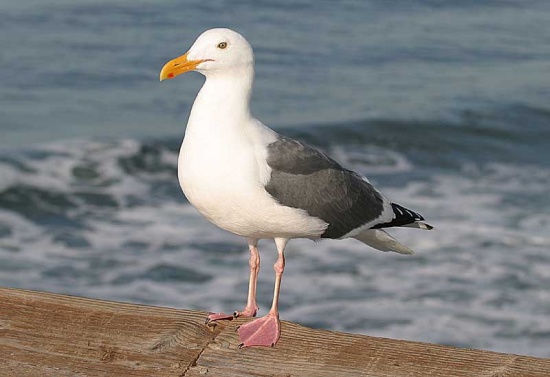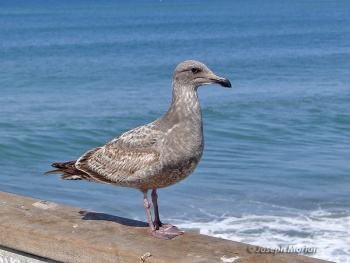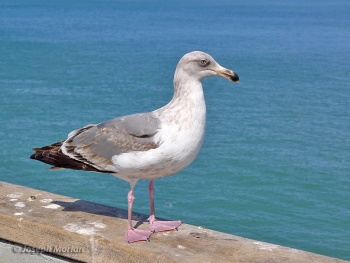- Larus occidentalis

Photo © by Fulmar.
Newport Beach, Orange County, California, USA, 9 February 2004
Identification

Photo © by Joseph Morlan.
Pacifica, San Mateo County, California, USA, 16 March 2020
54–66 cm (21¼-26 in)
Adults have a white head and body, dark grey wings, yellow bill with a red gonydeal spot, pink legs and feet. Immatures start out all dark with a vinaceous tone and a black bill with a bulbous tip. Second cycle birds are whiter below with a dark gray saddle and some yellow in the bill. Third cycle birds are similar to adults but have dark spots on the tail, a brownish wash to the wing coverts and a dark smudge on the bill.
Similar Species
It closely resembles the Slaty-backed Gull (Larus schistisagus) of East Asia but their ranges do not normally overlap.
Variations
Populations from southern California have a darker mantle than those breeding north of Monterey.
Hybridisation
At the northern end of its range often hybridizes with the Glaucous-winged Gull, a combination known as the "Olympic Gull" or "Puget Sound Gull." These birds disperse south after breeding as far as northern California where they can be confused with other species.
Distribution

Photo © by Joseph Morlan.
Pacifica, San Mateo County, California, USA, 16 March 2020
Pacific coast of North America from British Columbia to northern Baja California, Mexico.
Taxonomy
Subspecies
There are 2 subspecies[1]:
- L. o. occidentalis:
- Pacific coast of British Columbia to central California
- L. o. wymani:
- Central California (Monterey Bay) to southern Baja California
Habitat
Rocky shoreline.
Behaviour
Breeding
It builds a nest of vegetation inside the territory, and 3 eggs are laid; these are incubated for a month. The chicks, once hatched, remain inside the territory until they have fledged.
Diet
The diet includes fish, invertebrates like krill, squid and jellyfish; on land they feed on seal and sea lion carcasses, as well as cockles, limpets and snails in the intertidal zone. They will also use human-altered habitats, feeding at landfills and taking food from people at marinas and beaches.
Vocalisation
Has a typical accelerating long call similar to that of other large gulls. Introduction is longer and lower followed by louder and higher-pitched with little variation. Final notes are flatter and lower-pitched often changing into a series of yelps.
Movements
Mostly resident but disperses along the coast after breeding. Some move north to southwestern British Columbia, as far as Vancouver. Very rare away from the immediate coast.
References
- Clements, J. F., T. S. Schulenberg, M. J. Iliff, S. M. Billerman, T. A. Fredericks, B. L. Sullivan, and C. L. Wood. 2019. The eBird/Clements Checklist of Birds of the World: v2019. Downloaded from http://www.birds.cornell.edu/clementschecklist/download/
- Pierotti, R. J. and C. A. Annett (2020). Western Gull (Larus occidentalis), version 1.0. In Birds of the World (A. F. Poole and F. B. Gill, Editors). Cornell Lab of Ornithology, Ithaca, NY, USA. https://doi.org/10.2173/bow.wesgul.01
- Burger, J., Gochfeld, M. & Garcia, E.F.J. (2020). Western Gull (Larus occidentalis). In: del Hoyo, J., Elliott, A., Sargatal, J., Christie, D.A. & de Juana, E. (eds.). Handbook of the Birds of the World Alive. Lynx Edicions, Barcelona. (retrieved from https://www.hbw.com/node/53977 on 17 March 2020).
- Howell, S.N.G. & Dunn, J.L. (2007) Gulls of the Americas. Houghton Mifflin, Boston.
- Malling Olsen, K. & Larsson, H. (2003) Gulls of Europe, Asia and North America. Christopher Helm, London.
Recommended Citation
- BirdForum Opus contributors. (2025) Western Gull. In: BirdForum, the forum for wild birds and birding. Retrieved 11 May 2025 from https://www.birdforum.net/opus/Western_Gull
External Links
GSearch checked for 2020 platform.1




